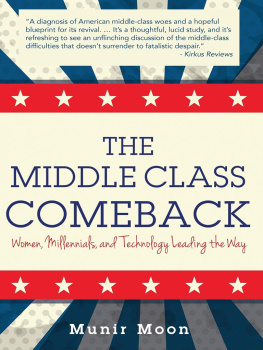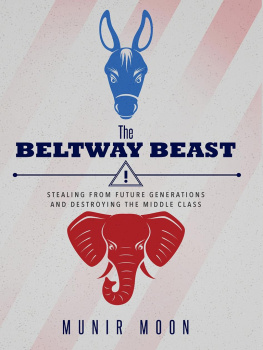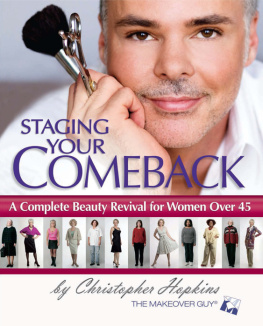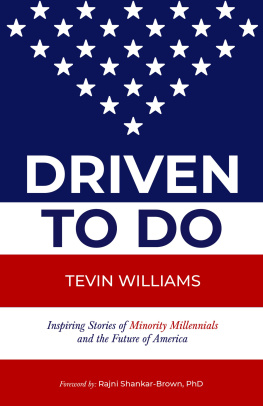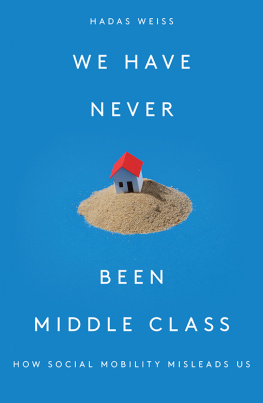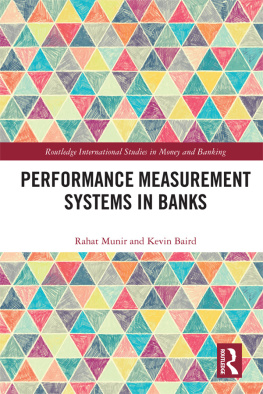Copyright 2017 Munir Moon
All rights reserved. No part of this publication may be reproduced, distributed, or transmitted in any form or by any means, including photocopying, recording, or other electronic or mechanical methods, without the prior written permission of the author. For permission requests, please write to:
MGN Press
640 Maple Avenue
Torrance, CA 90503
info@mgnpress.com
Printed in the United States of America
First Printing, 2016
10 9 8 7 6 5 4 3 2 1
Publishers Cataloging-in-Publication data
Moon, Munir
The Middle Class Comeback: Women, Millennials, and Technology Leading the Way/ by Munir Moon.
p. cm.
ISBN 978-0-9913721-7-1 (e-book)
ISBN 978-0-9913721-6-4 (Hardcover)
ISBN-13: 9780991372164
ISBN-10: 0991372166
Library of Congress Control Number: 2016908136
1. The United States Politics. 2. Current Affairs. 3. Healthcare. 4. Economy United States.
Introduction
T he middle class is the hallmark of the American dream and the backbone of a free and strong society. That dream has been shattered in recent decades for many Americans. Most of the media and politicians define the middle class by income, which has been stagnant at best or declining at worst for the average American. However, it is the cost of living as well as higher taxes that are larger factors adversely impacting the middle class. Moreover, government policies have exacerbated the middle-class decline.
This book argues that the cost of education, healthcare, housing, and taxes have increased at a much higher rate than the income. One can look at the middle-class challenge as a glass half full or half empty. The premise of this book is that the glass is half full and that the middle class will come back despite all the doom and gloom about its demise.
Middle-class America is defined as a family of four including two school-aged children earning between $51,000 and $123,000 per year. They aspire to attain affordable healthcare, college education for their children, a home, and retirement security. This book focuses on the jobs and ever rising cost of healthcare, education, and taxesmost of which can be attributed to the governments counterproductive policies and dysfunctional political structure. This book highlights various components that will result in the middle class comeback instead of an in-depth analysis of each category in the interest of keeping the book short. Almost 400 citations are provided for further reading.
That disparity would serve as the impetus for the middle-class comeback by challenging the old way of doing business, both in private companies and government agencies.
One of the reasons for that optimism is women gaining ground with men in almost every segment of society, such as higher education, medicine, and business. Moreover, women control $11 trillion, or almost 40 percent, of the nations investable assets. Women make up half of the population, yet they are still well under-represented in society when it comes to making decisions in private and public deliberations on the economy, education, healthcare, politics, and social issues. As women gain more parity with men, such as in the job market, they will contribute more money to the family income and will lead the way toward the middle-class comeback.
Millennials, who represent 25 percent of the adult population, will be the largest voting bloc over the next few decades. They are projected to inherit $30 trillion from their baby boomer parents. Millennials are transforming existing industries while creating new ones whether it is in communication, media, or goods and services. They are creating jobs, enhancing purchasing power, and improving the quality of life for the middle class.
The technology will force the existing private and public institutional structures to be efficient amid the digital age. Over the last thirty years, technology has made astounding changes. Smartphones and other technological products that are very complex yet very simple to use will continue to add productivity to the economy. Just as the auto industry had a major impact on the growth of the middle class in the early twentieth-century, technology will do the same in the twenty-first century. This will result in the transformation of education, healthcare, the political system, and the tax structure. As a result, their costs will decrease, which will increase the purchasing power of the lower and middle class.
It would be nave to think that change will come overnight, but the transformation of healthcare and education is already underway. Moreover, the 2016 election was a watershed moment in United States history in all likelihood. The American public is so frustrated and angry with Washington and professional politicians that they are willing to accept a businessman like Donald Trump, who has no political experience, as the leader of the free world.
Rising healthcare costs have taken more and more money out of the pockets of middle-class households. They have been and will continue to be a drain on the national economy as the aging population grows under the current healthcare delivery model. The Affordable Care Act (ACA) primarily focuses on health insurance coverage for every American rather than reducing healthcare costs so that it is affordable.
The unintended consequence of the ACA is that the businesses have and will continue to shift the healthcare costs to employees by increasing deductibles and copayments to meet the mandate and maintain their profitability. As consumers are forced to pay more out-of-pocket expenses toward their healthcare costs, they will have more incentives to shop for a better value. That will bring competition to bear, as it does not exist under the current healthcare delivery system. Combining competition with technological innovations will redefine healthcare and make it more affordable.
College education is another factor that has been consuming the greater share of an average middle-class familys budget. The nation still uses an eighteenth-century Prussian model imported from Germany to educate children, a production model where students move up a grade every year. However, the advent of online learning and the skyrocketing tuition costs will make the current model to earn a bachelors degree a relic of the past. College tuition could be reduced by as much as 50 percent by deploying online learning and reducing the physical presence of the students to two years through apprenticeships, internships, and study abroad programs.
Middle-class America has been devastated by the 2008 housing crisis where the median American family lost 39 percent of its net worth from $126,000 in 2007 to $77,300 in 2010, three-quarters of which can be attributed to the home value. The housing sector has been improving as families regain financial stability while mortgage rates are at a historic low since the financial crisis of 2008. However, the demographic shift due to millennials may redefine whether home ownership is as important as it was to the previous generation.
Americans have been taxed everywhere they look; some are direct, and others are disguised as fees, fines, penalties, or anything but the word tax. The penalty imposed by the ACA if one does not have health insurance coverage is one of the newest. Then there is a 48-cent federal and state tax on every gallon of gas. A disproportionate burden of all these taxes falls on the middle class since they represent a larger percent of their earnings compared to the top one-percenters.

